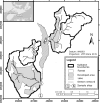Comparison of the Prevalences and Diversities of Listeria Species and Listeria monocytogenes in an Urban and a Rural Agricultural Watershed
- PMID: 25819965
- PMCID: PMC4421070
- DOI: 10.1128/AEM.00416-15
Comparison of the Prevalences and Diversities of Listeria Species and Listeria monocytogenes in an Urban and a Rural Agricultural Watershed
Abstract
Foods and related processing environments are commonly contaminated with the pathogenic Listeria monocytogenes. To investigate potential environmental reservoirs of Listeria spp. and L. monocytogenes, surface water and point source pollution samples from an urban and a rural municipal water supply watershed in Nova Scotia, Canada, were examined over 18 months. Presumptive Listeria spp. were cultured from 72 and 35% of rural and urban water samples, respectively, with 24% of the positive samples containing two or three different Listeria spp. The L. innocua (56%) and L. welshimeri (43%) groups were predominant in the rural and urban watersheds, respectively. Analysis by the TaqMan assay showed a significantly (P < 0.05) higher prevalence of L. monocytogenes of 62% versus 17% by the culture-based method. Both methods revealed higher prevalences in the rural watershed and during the fall and winter seasons. Elevated Escherichia coli (≥ 100 CFU/100 ml) levels were not associated with the pathogen regardless of the detection method. Isolation of Listeria spp. were associated with 70 times higher odds of isolating L. monocytogenes (odds ratio = 70; P < 0.001). Serogroup IIa was predominant (67.7%) among the 285 L. monocytogenes isolates, followed by IVb (16.1%), IIb (15.8%), and IIc (0.4%). L. monocytogenes was detected in cow feces and raw sewage but not in septic tank samples. Pulsotyping of representative water (n = 54) and local human (n = 19) isolates suggested genetic similarities among some environmental and human L. monocytogenes isolates. In conclusion, temperate surface waters contain a diverse Listeria species population and could be a potential reservoir for L. monocytogenes, especially in rural agricultural watersheds.
Copyright © 2015, American Society for Microbiology. All Rights Reserved.
Figures





References
-
- den Bakker HC, Warchocki S, Wright EM, Allred AF, Ahlstrom C, Manuel CS, Stasiewicz MJ, Burrell A, Roof S, Strawn LK, Fortes E, Nightingale KK, Kephart D, Wiedmann M. 2014. Listeria floridensis sp. nov., Listeria aquatica sp. nov., Listeria cornellensis sp. nov., Listeria riparia sp. nov. and Listeria grandensis sp. nov., from agricultural and natural environments. Int J Syst Evol Microbiol 64:1882–1889. doi:10.1099/ijs.0.052720-0. - DOI - PubMed
Publication types
MeSH terms
LinkOut - more resources
Full Text Sources
Miscellaneous

